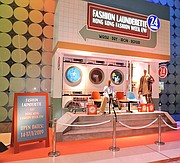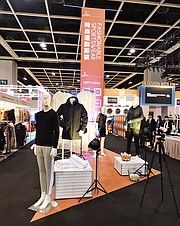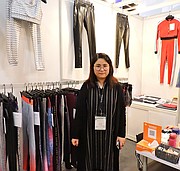TRADE SHOWS
Hong Kong Fashion Week Downsizes Amid U.S. Tariff Tiff
HONG KONG—Hong Kong Fashion Week had a subdued air this year as U.S. buyers have become more cautious about placing orders with Chinese factories, which make up the bulk of the exhibitors.
That also was reflected in the number of companies participating in the Fall/Winter 2019 trade-show event and fashion fair, which ran Jan. 14–17 in the Hong Kong Convention and Exhibition Centre. This year, there were only 1,400 booths from 11 countries, which is the same as last year but down from the 1,515 booths at the show two years ago. The usual contingent of about 25 Indian companies that usually exhibit at the show did not participate this year because their guild grant to attend the show didn’t arrive in time.
While U.S. buyers were not as abundant as in the past, there were a number of attendees from Europe, Indonesia and Australia who roamed one vast hall filled with sparkling evening gowns, scads of sweaters, beaded handbags, rows of denim and pint-sized clothing for children. In past years, the trade show has filled two large halls.
Benjamin Chau, the deputy executive director of show organizer Hong Kong Trade Development Council, noted exhibitors were facing uncertainties from the ongoing trade conflict between the United States and China, as well as rapid changes in sourcing and retail models.
Recently, the U.S. imposed a 10 percent tariff on $200 billion in Chinese imports and has threatened to expand that by another $257 billion, which would include almost everything imported from China. He urged clothing companies to grasp the opportunities presented by emerging-market buyers and stay competitive by improving design quality.
Laurence Leung, chairman of the Garment Advisory Committee of the Hong Kong Trade Development Council, and other officials acknowledged that U.S. tariffs on Chinese goods is affecting buyers’ confidence levels in placing orders with Chinese factories. “Right now they may be equally balanced in sourcing from Vietnam and China,” Leung said. “But this is becoming a no-brainer. They must be out of China. On the good side, the Chinese currency has depreciated more than 7 percent in the last year. So that helps.”
This was the 50th edition of Hong Kong Fashion Week, which is held every January and July as a trade show for womenswear, menswear, childrenswear, lingerie, swimwear, evening wear, handbags, shoes, accessories, fabrics, buttons and labels.
Last year, the show added a corporate fashion and uniform zone, popular for its offerings of stylish and tailored company uniforms. That section was back this year as were sections for fashionable sportswear, thermal clothing, bridal and evening wear, intimate wear and swimwear.
This year, exhibitors were having a hit-or-miss experience at the show. “I have met some good buyers,” said Rong Mao Cai, a sales manager for Shishi Greenlander Garment Co. in Fujian, China, which does stylish T-shirts with graphics and garment-dyed shorts.
He said the 20-year-old company, which has a factory with 150 workers, has most of its clients in Europe, South America and Asia. It doesn’t have a lot of customers in the United States. “I think the tariff is a big problem for retailers and consumers,” he said. While he was talking, a buyer from Mexico stopped by to peruse his apparel collection.
This was the seventh time that Oliver Huang, the business manager for Jiaxing Kailisilk Knitting near Shanghai, attended the show. He noted there were fewer U.S. buyers but more customers from Europe and the Middle East. But he did find the show slower than usual.
His family’s sweater factory has about 400 workers, which has held steady for the last few years. Most of his business is with Europe. Thirty-five percent of his business is with U.S. customers.
He said sweater sourcing is one business that is hard to shift if you are not a large-volume buyer because China is the biggest sweater producer in the world. “Our lead time on sweater orders is 70 days with LDP [landed duty paid] terms,” he said, noting his wholesale prices range from $5 for a polyester sweater to $60 for a cashmere coat. “If you place an order in Bangladesh, the lead time is 120 days, and they cannot do small orders.”
This was the first time that Vivian Fan and her company, Zhejiang Serand Mido Import & Export Co. in China, had attended the show to display leggings and athletic tops. Normally the athleticwear company with 60 workers attends the big Canton Fair in Guangzhou, China.
A few buyers had wandered by, attracted by the 3-D printing on many of the company’s leggings, but the sales manager was disappointed with the traffic flow. She was hoping to expand the 8-year-old company’s business beyond the United States. “About 80 percent of our customers are from the United States, and we have gotten them through the business-to-business platform Alibaba,” she said. “We have low minimums of 100, and that includes mixing sizes because we stock our fabric.” Her wholesale prices range from $5 to $9.
One of the few exhibitors from India was Akshat Bubna, the owner of Only For U Designs Pvt. Ltd. in Mumbai, India. He was showing colorful tunic tops made in his family’s factory. “I have been doing this show for the last five years,” he said. “It is a very slow show. If there are fewer exhibitors, then there will be fewer attendees. They need a special section for resortwear.”

























